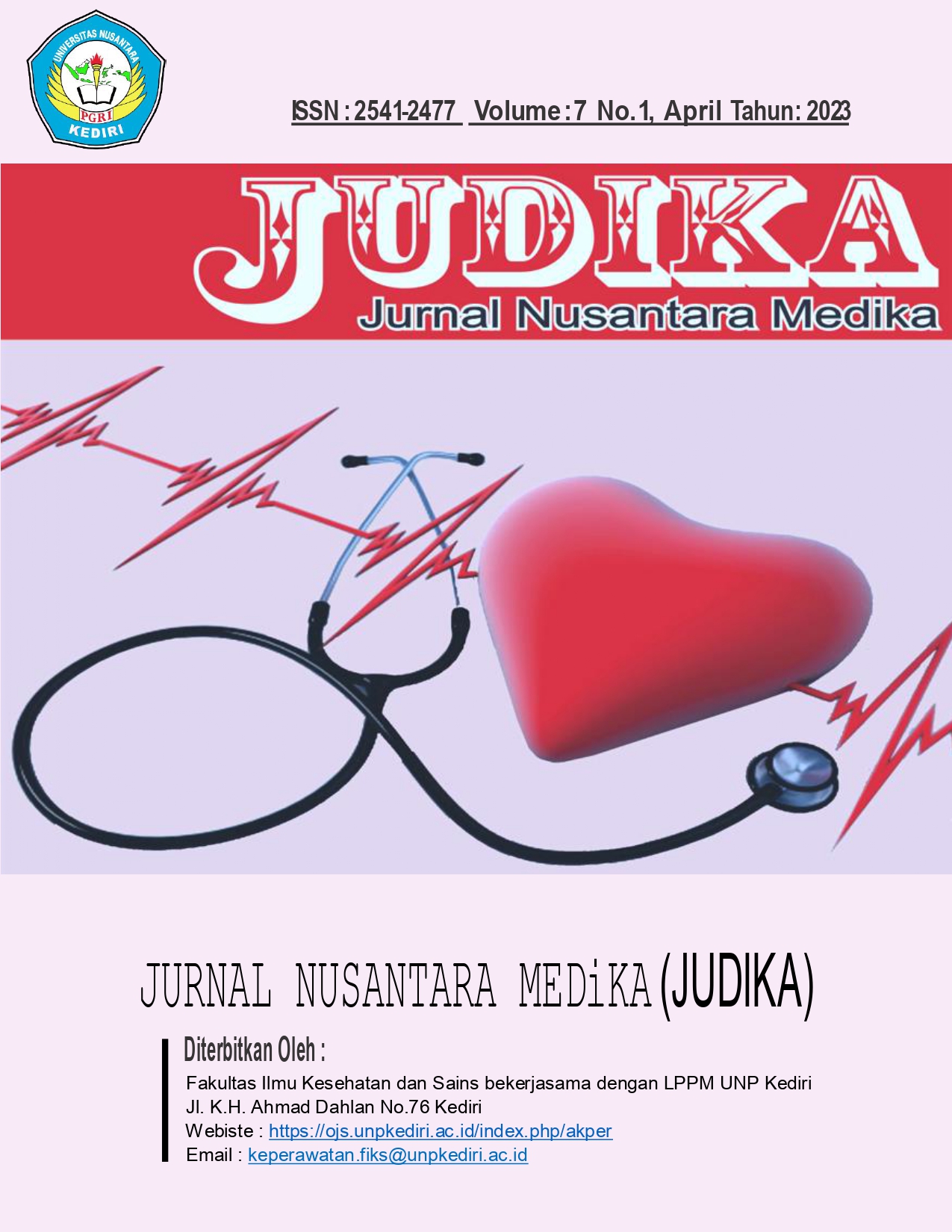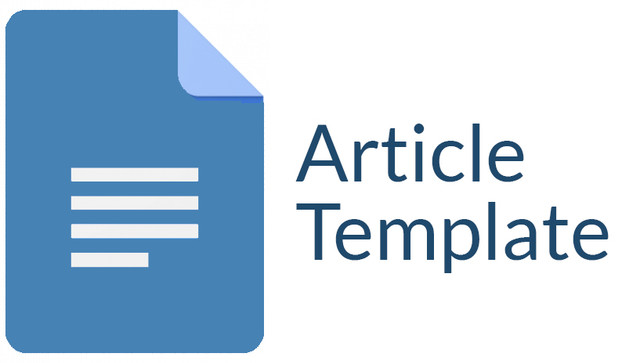Peningkatan Pengetahuan Penatalaksanaan Interik Neonatorum Fisiologis
DOI:
https://doi.org/10.29407/judika.v7i1.20039Keywords:
Pengetahuan, Ikteric NeonatusAbstract
Latar Belakang: Kejadian ikterik neonatus masih banyak terjadi di Indonesia bahkan di dunia. Hal ini banyak disebabkan karna kondisi polutan yang semakin banyak, penyakit bawaan dari ibu hamil bahkan dapat disebabkan karena pola hidup ibu hamil yang tidak sehat. Dampak dari ikterik neonatus dapat berjangka pajang salah satunya dapat menggangu tumbuh kembang bayi bahkan dapat merusak otak bayi atau kern ikterik yang tentunya dapat mengakibatkan kematian. Tujuan: Penelitian ini bertujan untuk mengetahuan pengaruh edukasi terstruktur dengan media edukasi audiovisual dan booklet terkait penatalaksanaan ikterik neonatus fisiologi pada ibu trimester 3. Metode: Metodologi penelitian yang digunakan dalam penelitian ini adalah pre experimental one group pre test – post test designs. Responden populasi pada penelitian ini sejumlah 213 ibu hamil trimester 3 dengan dilakukan perhitungan sampling dan pengambilan sampel dengan acak sejumlah 88 sampel. Hasil: Menunjukan perbedaan rata-rata pengetahuan responden sebelum dan sesudah diberikan edukasi ikterik neonatorum pada bayi menggunakan cara ceramah. Berdasarkan data yang telah diteliti telah didapatkan hasil sebelum pemberian edukasi didapatkan rata-rata nilai pengetahuan 64,22 dan setelah edukasi didapatkan nilai pengetahuan 83,41. Dari uji statistik t-test didapatkan hasil p value 0,001. Kesimpulan: Terdapat pengaruh edukasi ikterik neonatorum pada pengetahuan orang tua
Downloads
References
Ashebir, Y. G., Sebsibe, G. T., Gela, D., & Kebede, M. A. (2022). Attitudes of mothers attending public hospitals in Addis Ababa, Ethiopia, to neonatal sunlight exposure: a cross-sectional study. BMJ Paediatrics Open, 6(1), 1–8. https://doi.org/10.1136/bmjpo-2022-001554
Birhanu, M. Y., Workineh, A. A., Molla, Y., Abebaw, E., Arora, A., & Bazezew, Y. (2021). Rate and predictors of neonatal jaundice in northwest Ethiopia: Prospective cohort study. Journal of Multidisciplinary Healthcare, 14, 447–457. https://doi.org/10.2147/JMDH.S298034
Chen, C. F., Hsu, M. C., Shen, C. H., Wang, C. L., Chang, S. C., Wu, K. G., Wu, S. C., & Chen, S. J. (2011). Influence of breast-feeding on weight loss, jaundice, and waste elimination in neonates. Pediatrics and Neonatology, 52(2), 85–92. https://doi.org/10.1016/j.pedneo.2011.02.010
Firdaus, F., Hasina, S. N., Windarti, Y., & Wulandari, D. D. (2021). Breast Milk Management in the Efforts to Reduce Bilirubin Levels in Neonatal Jaundice. Open Access Macedonian Journal of Medical Sciences, 9(G), 300–305. https://doi.org/10.3889/oamjms.2021.7776
Heringguhir, S. A. (2022). Hubungan Usia Gestasi dan Berat Lahir Neonatus dengan Kejadian Ikterus Neonatorum di RSUD DR.M.Maulussy Ambon Tahun 2018-2022. PAMERI Pattimura Medical Riview, 4(2), 53–63.
Horn, D., Ehret, D., Gautham, K. S., & Soll, R. (2021). Sunlight for the prevention and treatment of hyperbilirubinemia in term and late preterm neonates. Cochrane Database of Systematic Reviews, 2021(7). https://doi.org/10.1002/14651858.CD013277.pub2
Huang, Y., Chen, L., Wang, X., Zhao, C., Guo, Z., Li, J., Yang, F., & Cai, W. (2022). Maternal knowledge, attitudes and practices related to neonatal jaundice and associated factors in Shenzhen, China: a facility-based cross-sectional study. BMJ Open, 12(8), 1–11. https://doi.org/10.1136/bmjopen-2021-057981
Iliyasu, Z., Farouk, Z., Lawal, A., Bello, M. M., Nass, N. S., & Aliyu, M. H. (2020). Care-seeking behavior for neonatal jaundice in rural northern Nigeria. Public Health in Practice, 1(April), 100006. https://doi.org/10.1016/j.puhip.2020.100006
Kementrian Kesehatan Republik Indonesia. (2019). Pedoman Nasional Pelayanan Kedokteran Tata Laksana Hiperbilirubinemia. Pedoman Nasional Pelayanan Kedokteran Tata Laksana Hiperbilirubinemia, 6(1), 5–10.
Rohani, S., & Wahyuni, R. (2017). Faktor-Faktor yang Berhubungan dengan Kejadian Ikterus pada Neonatus. Jurnal Aisyah : Jurnal Ilmu Kesehatan, 2(1), 75–80. https://doi.org/10.30604/jika.v2i1.35
Seneadza, N. A. H., Insaidoo, G., Boye, H., Ani-Amponsah, M., Leung, T., Meek, J., & Enweronu-Laryea, C. (2022). Neonatal jaundice in Ghanaian children: Assessing maternal knowledge, attitude, and perceptions. PLoS ONE, 17(3 March), 1–13. https://doi.org/10.1371/journal.pone.0264694
Slusher, T. M., Olusanya, B. O., Vreman, H. J., Wong, R. J., Brearley, A. M., Vaucher, Y. E., & Stevenson, D. K. (2013). Treatment of neonatal jaundice with filtered sunlight in Nigerian neonates: Study protocol of a non-inferiority, randomized controlled trial. Trials, 14(1), 1–10. https://doi.org/10.1186/1745-6215-14-446
Slusher, T. M., Vreman, H. J., Olusanya, B. O., Wong, R. J., Brearley, A. M., Vaucher, Y. E., & Stevenson, D. K. (2014). Safety and efficacy of filtered sunlight in treatment of jaundice in African neonates. Pediatrics, 133(6). https://doi.org/10.1542/peds.2013-3500
Slusher, T. M., Zamora, T. G., Appiah, D., Stanke, J. U., Strand, M. A., Lee, B. W., Richardson, S. B., Keating, E. M., Siddappa, A. M., & Olusanya, B. O. (2017). Burden of severe neonatal jaundice: A systematic review and meta-analysis. BMJ Paediatrics Open, 1(1). https://doi.org/10.1136/bmjpo-2017-000105
Tri Yasa P, A. H. S. (2001). Serum bilirubin concentration in breast-fed newborn babies at Larantuka General Hospital, East Flores. Paediatrica Indonesiana, 41(6), 284. https://doi.org/10.14238/pi41.6.2001.284-7
Wama, R. S. (2020). Gambaran kejadian ikterus neonatorum. Program Studi Kebidanan Program Sarjana Terapan Fakultas Ilmu Kesehatan Universitas ‘Aisyiyah Yogyakarta.
Wilde, V. K. (2022). Neonatal Jaundice and Autism: Precautionary Principle Invocation Overdue. Cureus, 14(2). https://doi.org/10.7759/cureus.22512
Yu, B., & Hu, F. (2021). Exploration of the pathogenic factors of neonatal jaundice and the clinical effect of blue phototherapy. American Journal of Translational Research, 13(6), 6802–6806.
Zhang, L., Liu, W., Hou, K., Lin, J., Song, C., Zhou, C., Huang, B., Tong, X., Wang, J., Rhine, W., Jiao, Y., Wang, Z., Ni, R., Liu, M., Zhang, L., Wang, Z., Wang, Y., Li, X., Liu, S., & Wang, Y. (2019). Air pollution exposure associates with increased risk of neonatal jaundice. Nature Communications, 10(1), 1–9. https://doi.org/10.1038/s41467-019-11387-3
Downloads
Published
Issue
Section
License
Authors who publish with this journal agree to the following terms:
- Copyright on any article is retained by the author(s).
- The author grants the journal, right of first publication with the work simultaneously licensed under a Creative Commons Attribution License that allows others to share the work with an acknowledgment of the work’s authorship and initial publication in this journal.
- Authors are able to enter into separate, additional contractual arrangements for the non-exclusive distribution of the journal’s published version of the work (e.g., post it to an institutional repository or publish it in a book), with an acknowledgment of its initial publication in this journal.
- Authors are permitted and encouraged to post their work online (e.g., in institutional repositories or on their website) prior to and during the submission process, as it can lead to productive exchanges, as well as earlier and greater citation of published work.
- The article and any associated published material is distributed under the Creative Commons Attribution-ShareAlike 4.0 International License













